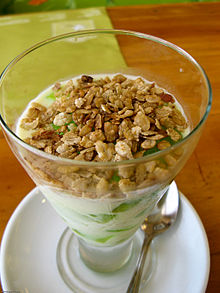food.wikisort.org - Dish
Pinipig is a flattened rice dish from the Philippines. It is made of immature grains of glutinous rice pounded until flat before being toasted. It is commonly used as toppings for various desserts in Filipino cuisine, but can also be eaten plain, made into cakes, or mixed with drinks and other dishes.[1][2][3]
 Pinipig toppings on buko pandan (a drink made from coconut meat, cream, and gulaman cubes flavored with pandan leaves) | |
| Place of origin | Philippines |
|---|---|
| Main ingredients | glutinous rice |
Production

Pinipig is made solely from glutinous rice (malagkit or "sticky" rice). The grains are harvested while still green. They are husked and the chaff is separated from the grain (traditionally using large flat winnowing baskets called bilao). The resulting bright green kernels are then pounded in large wooden mortars and pestles until flat. They are then toasted dry on pans or baked until crisp.[4][5]
Description
Pinipig are characteristically light green in color when fresh, but usually become yellowish white to brown when toasted. They superficially resemble grains of oats, and are often confused with puffed rice. The texture is crunchy on the exterior with a chewy center.[5][6]
Variants

A notable regional variant of the pinipig is the duman, which is made in Santa Rita, Pampanga in the Philippines. Duman, like pinipig, is also made from immature grains of glutinous rice, but it is toasted before it is pounded.[7]
A similar delicacy also exists called cốm in Vietnam and Thailand.[6]
See also
- Flattened rice
- Cốm, a similar dish in Vietnam which uses green rice grains
- Poha, a similar dish in South Asia which uses mature rice grains
- Ampaw
- Freekeh
- Rolled oats
References
- Alan Davidson, ed. (2014). The Oxford Companion to Food. Oxford University Press. p. 618. ISBN 9780199677337.
- Jean Donald Bowen, ed. (1965). Beginning Tagalog: A Course for Speakers of English. University of California Press. p. 85. ISBN 9780520001565.
- "Pinipig". Gourmet Sleuth. Retrieved 6 July 2015.
- Mellie Leandicho Lopez (2001). A Study of Philippine Games. University of the Philippines Press. p. 139. ISBN 9789715422956.
- "Pinipig vs. Pinipig…". Market Manila. 1 February 2015. Retrieved 6 July 2015.
- Jun Belen. "How to Make Kalamay na Pinipig (Pinipig Rice Cake)". junblog. Retrieved 6 July 2015.
- Mary Ann Quioc Tayag (11 December 2002). "For the love of duman". PhilStar. Retrieved 6 July 2015.
Другой контент может иметь иную лицензию. Перед использованием материалов сайта WikiSort.org внимательно изучите правила лицензирования конкретных элементов наполнения сайта.
WikiSort.org - проект по пересортировке и дополнению контента Википедии
